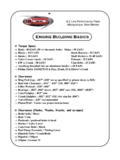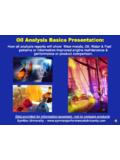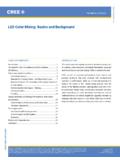Transcription of Building Energy Use and Cost Analysis Program …
1 1. volume Building Energy Use and cost Analysis Program volume 1: basics October 2004. LAWRENCE BERKELEY NATIONAL LABORATORY. JAMES J. HIRSCH & ASSOCIATES. Building Energy USE AND cost Analysis Program . volume 1: basics E. O. Lawrence Berkeley National Laboratory Simulation Research Group Berkeley, California 94720. James J. Hirsch & Associates 12185 Presilla Road. Camarillo, CA 93012-9243. Phone Fax Copyright 1995-2009 James J. Hirsch B A S I C S A C K N O W L E D G E M E N T S. Acknowledgements , both the Program and its documentation, are based upon earlier versions of DOE-2. The DOE-2 family of programs was created primarily through a partnership between James J.
2 Hirsch &. Associates (JJH) and Lawrence Berkeley National Laboratory (LBNL) with additional contributions, over a twenty five year period, from a large number of individuals and institutions around the world. Support for the continued development of DOE-2, over its two decades of wide distribution, has come from many public and private agencies, companies and educational institutions around the world. The primary support for DOE-2 development, however, has come from public funds provided by the United States Department of Energy (USDOE) and the United States electric and gas utility industry; particularly the USDOE Office of Energy Efficiency and Renewable Energy Building Technologies Program , Southern California Edison Company's Energy Efficiency Division, and the Electric Power Research Institute's Customer Systems Division.
3 Authorship of the Program components and documentation is an ongoing team effort that has its roots in previous versions going back over twenty-five years and we expect will continue into future decades. The contributions to DOE-2, both directly as authors and indirectly in the form of advice, comment and testing or feedback, are too numerous to catalog here; however, the primary authors are mentioned below in alphabetical order. Currently, and over the past decade, Marlin Addison, Scott Criswell, Steve Gates, Jeff Hirsch, and Kevin Madison, as consulting staff for JJH, are the major contributors to Fred Buhl, Ender Erdem, Kathy Ellington and Fred Winkelmann, as staff members of the Environmental Energy Technologies Division's Simulation Research Group at LBNL, were major contributors to the initial version of The primary contributors to the previous versions of DOE-2 ( , , , etc) were Fred Buhl, Ender Erdem, Kathy Ellington, Steve Gates, Jeff Hirsch and Fred Winkelmann, as LBNL staff and Steve Gates and Jeff Hirsch as consulting staff for JJH.
4 The authors of also wish to acknowledge many persons who, apart from the financial support provided by their organizations, have provided vision and insight that has been instrumental to the ongoing support of the DOE-2 family of products, including , , PowerDOE and eQUEST. In particular we express our thanks to Gregg Ander, and his staff, and Janith Johnson, and her staff, at Southern California Edison Company. i B A S I C S T A B L E O F C O N T E N T S. Table of Contents I. TABLE OF OVERVIEW .. 1. INTRODUCTION .. 1. Simulation Engine Structure .. 2. Uses for the Program .. 4. Validation of DOE-2 .. 5. Input 5. A SIMPLE INPUT/OUTPUT EXAMPLE.
5 8. Sample 9. Sample 14. Weather Files .. 22. Building DESCRIPTION LANGUAGE .. 23. 23. BDL Instructions .. 23. 24. U-names and Referenced Commands .. 25. LIKE 26. Comments .. 26. Input Styles .. 26. INPUT COMMAND .. 28. TITLE COMMAND .. 29. DIAGNOSTIC COMMAND .. 30. ABORT 31. RUN-PERIOD COMMAND .. 32. SCHEDULE, WEEK-SCHEDULE AND 33. DAY-SCHEDULE .. 33. WEEK-SCHEDULE .. 34. SCHEDULE .. 34. Nesting of Schedules .. 35. ENVELOPE COMPONENTS .. 36. 37. 39. LAYERS .. 41. CONSTRUCTION .. 44. 49. 50. Space Coordinates .. 50. Internal Loads .. 51. Air Infiltration .. 57. Alternative methods of describing 58. EXTERIOR-WALL OR ROOF .. 59. Alternative method for locating and sizing exterior walls or roofs.
6 61. WINDOW .. 62. Overhangs and Fins .. 64. 66. INTERIOR-WALL .. 67. Alternative method for locating and sizing interior 68. UNDERGROUND-WALL UNDERGROUND-FLOOR .. 69. 71. AIR-SIDE COMPONENTS .. 74. INTRODUCTION .. 74. Air Systems .. 74. Other Air Distribution System 78. ii B A S I C S T A B L E O F C O N T E N T S. Another Way of Classifying Air 80. SYSTEM .. 81. Airflow Parameters .. 83. System Control .. 86. System 90. Additional 92. ZONE .. 95. Zone 95. Zone Control .. 97. Additional 98. DAY-RESET-SCH AND RESET-SCHEDULE .. 99. HVAC AIR SYSTEM Single-Zone Fan System with Optional Subzone Reheat (SZRH) ..104. Constant- volume Reheat Fan System (RHFS).
7 107. Multizone Fan System (MZS)..111. Dual-Duct Fan System (DDS) ..115. Variable- volume Fan System with Optional Reheat (VAVS)..119. Powered Induction Unit (PIU)..123. Two-Pipe Fan Coil System (FC)..130. Four-Pipe Fan Coil System (FC)..133. Residential System (RESYS)..136. Packaged Single-Zone Air Conditioner (PSZ) ..140. Packaged Multizone Fan System (PMZS) ..143. Packaged Variable-Air- volume System (PVAVS) ..146. Packaged Terminal Air Conditioner (PTAC) ..149. Unit Heater (UHT)..152. Unit Ventilator (UVT) ..154. SYSTEMS-REPORT ..156. CENTRAL PLANT ELEC-METER ..158. FUEL-METER ..159. MASTER-METERS ..160. PUMP ..161. CHILLER ..166. Chiller Design and Operating Chiller Energy Consumption.
8 167. Chilled-Water Loop Attachment ..168. Attachment to Hot-Water or Steam Loop ..168. Attachment to Condenser Water ABSOR-1, ABSOR-2, and GAS-ABSOR Chiller ..169. HEAT-REJECTION ..170. Tower Circulation Loop and Condenser OPEN-TWR, OPEN-TWR&HX and DW-HEATER ..173. ECONOMIC COMPONENTS ..174. UTILITY-RATE ..175. BLOCK-CHARGE ..177. Yearly, Seasonal, and Time of Use BLOCK-CHARGEs ..179. Using TOU-SEASON-LINK ..182. SCHEDULE ..185. UTILITY-RATE TARIFF EXAMPLES ..186. ECONOMICS-REPORT ..189. APPENDICES ..190. A. ADDITIONAL CAPABILITIES ..191. B. BASIC OUTPUT REPORT LV-A: GENERAL PROJECT AND Building REPORT LV-D: DETAILS OF EXTERIOR SURFACES IN THE PROJECT.
9 199. REPORT LS-B: SPACE PEAK LOAD COMPONENTS <space name>..200. REPORT LS-C: Building PEAK LOAD COMPONENTS ..202. REPORT LS-D: Building MONTHLY LOADS SUMMARY ..204. REPORT SV-A: SYSTEM DESIGN PARAMETERS FOR <system name>..206. REPORT SS-A: SYSTEM LOADS SUMMARY FOR <system name> ..210. REPORT SS-D: Building HVAC LOAD REPORT SS-H: SYSTEM UTILITY Energy USE FOR <system name>..214. iii B A S I C S T A B L E O F C O N T E N T S. REPORT SS-L: FAN ELECTRIC Energy USE FOR <system name> ..216. REPORT SS-M: Building HVAC FAN ELEC REPORT SS-N: RELATIVE HUMIDITY SUMMARY FOR <system name> ..219. REPORT SS-O: SPACE TEMPERATURE SUMMARY FOR <zone name>..220.
10 REPORT PS-A: PLANT Energy UTILIZATION ..221. REPORT PS-B: UTILITY AND FUEL USE SUMMARY ..223. REPORT BEPS: Building Energy PERFORMANCE ..224. REPORT ES-D: Energy cost REPORT ES-E: SUMMARY OF UTILITY-RATE: <utility rate name> ..227. iv B A S I C S. 1. Section Overview INTRODUCTION. What Is DOE-2? DOE-2 is a set of computer programs that provide an up-to-date, unbiased Analysis of a Building 's Energy consumption. DOE-2 predicts the hourly Energy use and Energy cost of a Building given hourly weather information and a description of the Building and its HVAC equipment and utility rate structure. Using the Program , designers can determine the choice of Building parameters that improve Energy efficiency while maintaining thermal comfort and cost -effectiveness.









